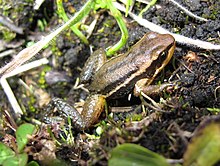Hyloxalus anthracinus
| Hyloxalus anthracinus | |
|---|---|

| |
| Scientific classification | |
| Domain: | Eukaryota |
| Kingdom: | Animalia |
| Phylum: | Chordata |
| Class: | Amphibia |
| Order: | Anura |
| Family: | Dendrobatidae |
| Genus: | Hyloxalus |
| Species: | H. anthracinus
|
| Binomial name | |
| Hyloxalus anthracinus (Edwards, 1971)
| |
| Synonyms[2] | |
| |
The South American rocket frog (Hyloxalus anthracinus) is a frog. It lives in Ecuador.[2][3][1]
Body
[change | change source]The adult male frog is about 16.2–19.0 mm long from nose to rear end and the adult female frog is 17.1-23.6 mm long. This frog has no webbed skin on any of its four feet. The skin of the frog's back is blurry with lighter marks. Some frogs also have black marks. There is a black line from the shoulder to the rear end. Big male frogs have darker bellies than small male frogs. Older female frogs have more spots on their throats than young female frogs. Female frogs have white bellies. The male frog's male organs are white in color.[3]
Name
[change | change source]Scientists named this frog anthracinus for anthracite coal because the frog's stripe are as black as coal.<refname=Amph />
Home
[change | change source]This frog lives in a special kind of forest called paramo and in other forests on mountains where there is water in the air. People have seen this frog on bromeliads plants and under dead trees and rocks near streams. People have seen this frog between 2185 and 3860 meters above sea level.[1]
Many of the places the frog lives are protected parks, for example Parque Nacional Sangay, Parque Nacional Rio Negro Sopladora, Parque Nacional Cajas, and Siete Iglesias.[1]
Young
[change | change source]Scientists think that the female frog lays eggs on the ground and that the male frogs carry the tadpoles to streams.[1]
Danger
[change | change source]Scientists say this frog is in big danger of dying out. People cut down trees where the frog lives to make farms and other things that people need. The fungal disease chytridiomycosis could also kill this frog.[1]
References
[change | change source]- ↑ 1.0 1.1 1.2 1.3 1.4 1.5 IUCN SSC Amphibian Specialist Group (2022). "South American Rocket Frog: Hyloxalus anthracinus". IUCN Red List of Threatened Species. 2022: e.T55046A98643979. doi:10.2305/IUCN.UK.2022-2.RLTS.T55046A98643979.en. Retrieved August 13, 2024.
- ↑ 2.0 2.1 Frost, Darrel R. "Hyloxalus anthracinus (Edwards, 1971)". Amphibian Species of the World, an Online Reference. Version 6.0. American Museum of Natural History, New York. Retrieved August 13, 2024.
- ↑ 3.0 3.1 Luis A. Coloma; Diego A. Ortiz; Caty Frenkel (May 6, 2013). Luis A. Coloma (ed.). "Hyloxalus anthracinus (Edwards, 1971)". AmphibiaWeb (in Spanish). University of California, Berkeley. Retrieved August 13, 2024.
